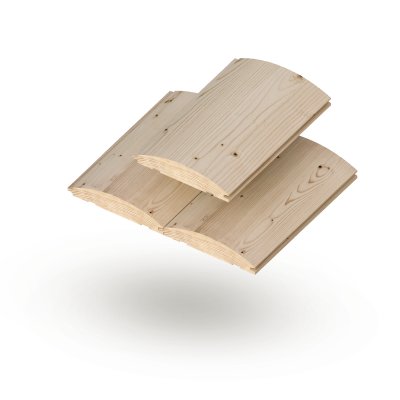 |
Block house
A block house is a planed board - a type of lining made in the form of a rounded log segment or profiled timber. It is intended for internal and external decorative finishing of rooms and buildings.
Part number:
Supplier:
LLC "Luzales"Description
Block house is most often made of coniferous wood - pine, spruce. The production of block-house lining is possible from aspen, birch.
On an industrial scale, a block house is made from a log according to the “square in a circle” scheme, when a board or a bar is made from the central part of a log with a rectangular section, and from the edges (with a wane or semi-wane) a lining of the “block house” type is made. "Block house" is also produced as an ordinary lining by processing edged boards on a four-sided milling machine. The workpiece is fed to rotating cutters that make a tongue (thorn), groove, rounding on the front side.
The block house is produced in lengths from 2,000 to 6,000 mm, depending on the manufacturer. LLC "Luzales" produces a block house up to 4,000 mm long.
The width of such a lining is measured as the useful width of the front surface, and the thickness is the maximum thickness of the board, regardless of the section. "block house" is produced in lengths from 2,000 to. The width of such a lining is measured as the useful width of the front surface, and the thickness is the maximum thickness of the board, regardless of the section. In Russia, the following sizes are most common: 20 × 90 mm; 30 × 140 mm; 36 × 190 mm.
The block house is divided by quality into two classes "A" and "B".
Class "A" allows strong knots with minor damage, as well as healthy knots, resin pockets and wormholes up to 3 mm wide, but not more than 50 cm long per m.
Class "B" assumes healthy dark knots up to 45 mm in size, not ingrown knots up to 65 mm and knots with damage, cracks up to 1 mm thick in total not exceeding a quarter of the product. In addition, resin pockets and wormholes with a width of no more than 8 mm are acceptable.
Installation of a block house is carried out by laying on a prepared surface. The installation process starts from the bottom up. The first board is installed evenly and horizontally. For external cladding, the panels are installed with the groove down to prevent moisture from entering. With the inner lining, the boards are installed with the groove up - this allows you to more effectively mask the joints. The panels are fastened by connecting them: the tongue is driven into the groove, ensuring a snug fit of the panels to each other.
Block house, as a finishing material, became popular in the early 90s of the XX century and quickly conquered the European market.
Currently, it is one of the most popular building materials made of natural wood.
On an industrial scale, a block house is made from a log according to the “square in a circle” scheme, when a board or a bar is made from the central part of a log with a rectangular section, and from the edges (with a wane or semi-wane) a lining of the “block house” type is made. "Block house" is also produced as an ordinary lining by processing edged boards on a four-sided milling machine. The workpiece is fed to rotating cutters that make a tongue (thorn), groove, rounding on the front side.
The block house is produced in lengths from 2,000 to 6,000 mm, depending on the manufacturer. LLC "Luzales" produces a block house up to 4,000 mm long.
The width of such a lining is measured as the useful width of the front surface, and the thickness is the maximum thickness of the board, regardless of the section. "block house" is produced in lengths from 2,000 to. The width of such a lining is measured as the useful width of the front surface, and the thickness is the maximum thickness of the board, regardless of the section. In Russia, the following sizes are most common: 20 × 90 mm; 30 × 140 mm; 36 × 190 mm.
The block house is divided by quality into two classes "A" and "B".
Class "A" allows strong knots with minor damage, as well as healthy knots, resin pockets and wormholes up to 3 mm wide, but not more than 50 cm long per m.
Class "B" assumes healthy dark knots up to 45 mm in size, not ingrown knots up to 65 mm and knots with damage, cracks up to 1 mm thick in total not exceeding a quarter of the product. In addition, resin pockets and wormholes with a width of no more than 8 mm are acceptable.
Installation of a block house is carried out by laying on a prepared surface. The installation process starts from the bottom up. The first board is installed evenly and horizontally. For external cladding, the panels are installed with the groove down to prevent moisture from entering. With the inner lining, the boards are installed with the groove up - this allows you to more effectively mask the joints. The panels are fastened by connecting them: the tongue is driven into the groove, ensuring a snug fit of the panels to each other.
Block house, as a finishing material, became popular in the early 90s of the XX century and quickly conquered the European market.
Currently, it is one of the most popular building materials made of natural wood.